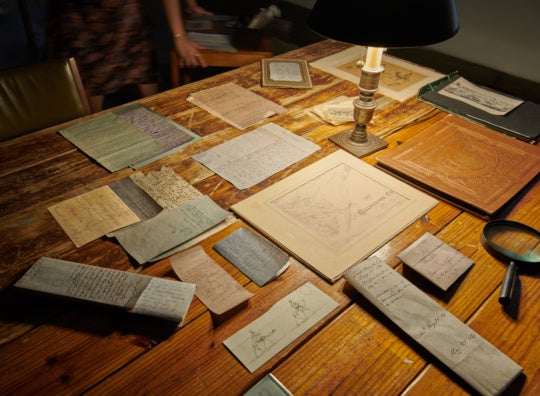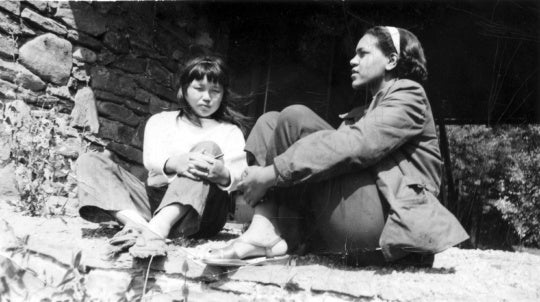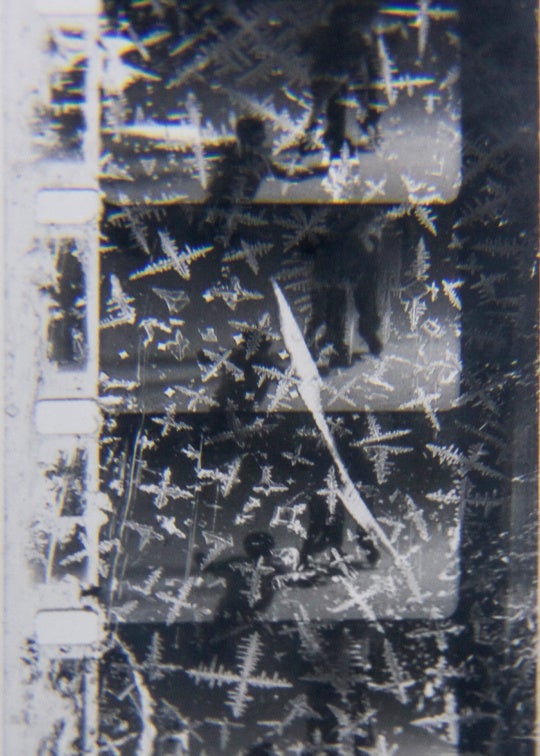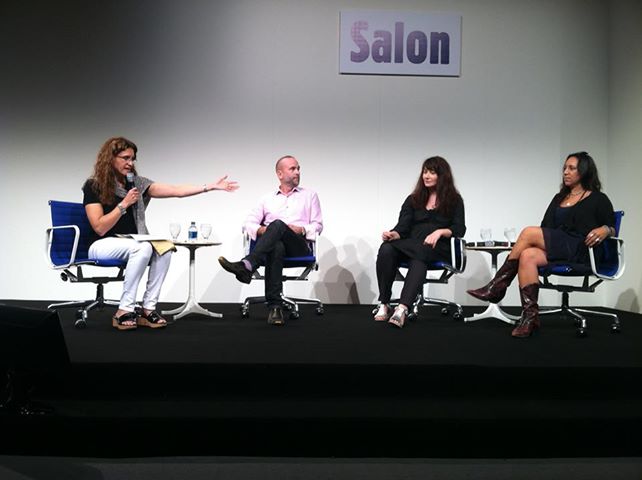
and curator Shamim Momin, at Art Basel Miami Beach, December 7, 2013. Photo: Buzz Spector.
The new book “Living and Sustaining a Creative Life: Essays by 40 Working Artists” reveals, in 40 essays, how working artists balance their creative and career needs with what financially and emotionally supports them. Published in October by Intellect Books and distributed by the University of Chicago Press, it quickly sold out two runs, and a quarter of the third is already pre-ordered. We asked Nashville-based Adrienne Outlaw, who contributed an essay to the collection, to discuss the project with New York artist Sharon Louden, who conceived and edited the book.
Adrienne Outlaw: Why did you decide to do this book?
Sharon Louden: When I came out of school thousands of dollars in debt, I was looking for ways to make a living. It was very difficult to carve out a living and to figure out how to make work at the same time. I wish I had had more of a community around me for support. Knowing that artists are still seeking answers, examples, and road maps, I thought I would ask 40 people I respect to reveal their paths for others to learn from.
AO: It’s unusual for a publisher to have a studio artist write a book. How did it come about?
SL: I did a panel discussion at the College Art Association Conference two and a half years ago [“Making a Living as an Artist: With or Without a Dealer,” 2011], and Intellect Books approached me afterwards.
AO: How did you select the contributors? [They include Sharon Butler, Amanda Church, Maureen Connor, Will Cotton, Jennifer Dalton, Karin Davie, Michelle Grabner, the Art Guys, Ellen Harvey, Julie Heffernan, Laurie Hogin, David Humphrey, Julie Langsam, Brian Novatny, Amy Pleasant, Kate Shepherd, Austin Thomas, Brian Tolle, and Michael Waugh. To see the complete list, click here.]
SL: I had to trust each of the contributors and know them well enough to be sure that they could be candid and tell the truth. So, I selected 19 artists from New York, 19 artists from the rest of the U.S. and two artists from Europe, all aged 30-66, who give a wide range of stories and experiences to learn from. Depending on the personality of the artist, some of the essays are opaque—their essays start a conversation—and some are transparent—they complete a thought and/or conversation. There is a lot to choose from.
AO: Some of the artists you included are real powerhouses in the art world. Where many seem to think that success is based on talent or luck, few recognize that the road is curvy and that success more often includes a significant work ethic. Michelle Grabner, for instance, advocates for hard work, putting her nose to the grindstone both to meet her goals and to create balance in her life. At the same time she possesses a generosity I think not many artists seem able to share—a generosity I think you have as well. What are some of the lessons learned from artists who have achieved so much?
SL: That they work so, so hard and that they are generous. That is the key. The life lesson is to share, to be generous, to be positive, to be truthful, to be humble, to be vulnerable, to be a part of a community. In fact, Adam Grant (the youngest professor at the Wharton School at the University of Pennsylvania), has studied this phenomenon of Givers vs. Takers and has shown that Givers— those who share in a positive way—have far more success over the long run than selfish Takers. It’s very clear that it’s better to be a Giver instead of a Taker, not only because it makes the world a better place but because, in the long run, it will help your career (and make you feel great at the same time!).
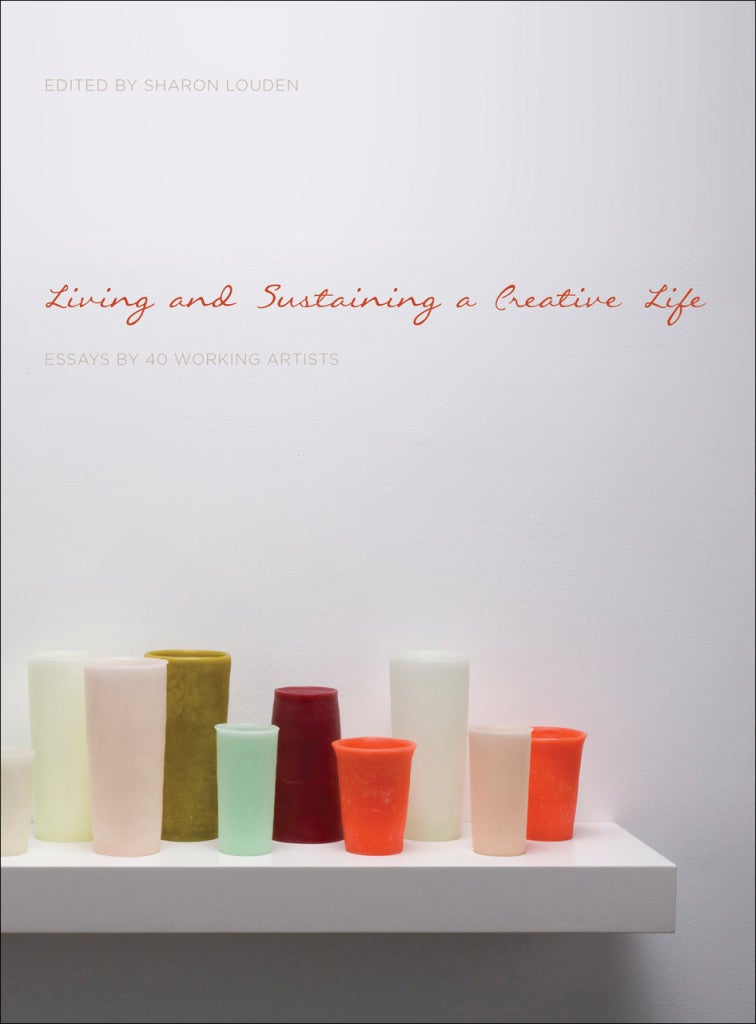 AO: You were recently in Nashville to lead several professional development workshops. At the end of the one of the workshops a participant said to me, “This has been so helpful. I have run other businesses, and I hadn’t thought I could just translate those business practices to the business of art making.” This comment made me start thinking that your book could be helpful to a wide variety of creative people. Can you talk a little bit more about how the practices discussed might apply to anybody?
AO: You were recently in Nashville to lead several professional development workshops. At the end of the one of the workshops a participant said to me, “This has been so helpful. I have run other businesses, and I hadn’t thought I could just translate those business practices to the business of art making.” This comment made me start thinking that your book could be helpful to a wide variety of creative people. Can you talk a little bit more about how the practices discussed might apply to anybody?
A lot of the essays talk about organization of time, and they share other road maps that are great examples for anyone who wants to learn how creativity can maximize their life. Also broadly applicable are the concepts of reaching for different ideas and risk taking—and there are various ranges and levels of risk taking, depending on the person’s personality, their situation, and where they live. I think everybody can find something in this book that applies to them.
AO: I think something that few people realize is that, almost regardless of an artist’s (and we can extend this to writers, curators, musicians, dancers, etc.) level of critical acclaim, they still face significant financial struggles, which are laid evident in the book. Can you talk about a few of the essays and what you learned from them in terms of how they made it work?
SL: David Humphrey keeps his expenses down by paying low rent; Brian Tolle has become very successful landing public art projects that provide a large portion of his income; Julie Heffernan not only supports her life through sales but also a teaching position; Brian Novatny has a lot of gallery representation, but he supports himself as a freelance art handler. There are many road maps and examples through the essays in this book. The common theme among the artists is that they are all working extremely hard and doing everything they can to succeed, with or without a gallery.
AO: You don’t have an essay in the book—how have you learned to make it work?
SL: By applying for everything, thinking creatively outside of the studio, being open to different possibilities, practicing heavy research, building a good mailing list/database and never giving up. I have made income through public art, sales, a few grants; and a terrific amount of cold calls. And I have also gotten better at creating budgets that cover my expenses so I don’t lose money on projects anymore.
AO: How do you view projects like this book in relation to your studio work?
This book is an extension of my studio practice; it informs my work in allowing me to get to know these artists more. It allows me to have a sense of and expands my community. It gives me a sense of confidence in my studio. It brings more awareness to my life, but it also extends my teaching practice. I teach professional development as well as contemporary approaches to painting, drawing, and installation. And I also believe that it’s very important for an artist to share and to give to other artists.
AO: Many of the contributors have someone helping them in a significant way—from a life partner acting as project manager or main breadwinner, not to mention therapist for the rise and fall of a career—things that galleries don’t as readily provide. Can you talk about the importance of such relationships for artists?
SL: I believe it takes a village for an artist to thrive and to sustain their creative life. Whether it is a life partner, an accountant, a lawyer, a framer, a website designer, a photographer, an art handler, a shipper, an artist assistant, a banker, a gallerist, a consultant—there can be a lot of people involved, and they are all essential in order for an artist to be able to freely create. It’s up to the artist to ask for assistance, for collaboration, to be a community-team-player.
AO: I think one of the reasons artists don’t have a structured community is that we are often working so hard in our studios and in the world—often at hourly jobs—to make ends meet. After putting this book together, what advice do you have for artists to make the time to form that community?
SL: I don’t think it takes too much to make that community. Giving to others is a natural extension of the dialogue in our studios between ourselves and our work, and our work and the public. Extensions of that dialogue include supporting other artists’ work by attending their exhibitions, getting their work out in social media, sharing, commenting, meeting with them, and many other activities. The sky is the limit when creating and contributing to a community.
AO: You have a real commitment to building community. Can you talk a little bit about how you think this book will help people learn to build a community?
The book is a great example of 40 artists coming together in one place and, through me and this project, being accessible and sharing. Each of these artists has volunteered their time, energy, and efforts to bring to the public a sense of what it’s like to have a creative life. We did not get an advance stipend to do this book. The contributors and I wanted to reach out to other artists in the spirit of giving. I believe that’s what’s so wonderful about the artistic community: everybody wants to be able to share and give. I believe that has to happen more. I wouldn’t say everybody, but I would say that most artists would like to have the opportunity to be involved in such a way.
AO: The tour is taking you to many cities, including Miami for Art Basel. Are you enjoying it? What are the highlights?
SL: I am enjoying the tour quite a bit because I’m meeting many different, lovely people along the way. I’m finding that many of the questions are centered around what “success” means for someone who is creative. It is incredibly encouraging to me that this book is providing a platform to discuss these nuts-and-bolts. There is no one way to “succeed.” Of course, the reader will determine what success means after reading the essays, but the debate continues at each stop of the book tour.
AO: What are your most memorable passages in the book? What do you like about them?
SL: My favorite is the last paragraph of the Art Guys’ essay, because their “offer” at the end always makes me laugh: “Business, capitalism, branding, marketing and advertising are ingrained in the American culture. As artists, we consider it our duty to investigate, experiment with and question all of this. For many years, we have done so and now we think we’re finally getting somewhere. May we give you our card?” There are also several passages of George Stoll’s frank essay that resonate with me. I can hear his voice in his writing, which is refreshing and wonderful.
AO: What, if anything, did you learn both from the essays and from putting the book together?
SL: That every artist, no matter what the perception is of them—whether they are making a lot of money or not, whether they are recognized as much as others, or if they are older or younger than others—they are all on the same page: a working artist is a working artist. And man, do they work hard. And love it.
Sharon Louden’s solo show opens January 7 at Beta Pictoris/Maus Contemporary Art in Birmingham, Alabama, where she will be joined by Michael Straus, chairman of the Andy Warhol Foundation for the Visual Arts, for a book signing.

